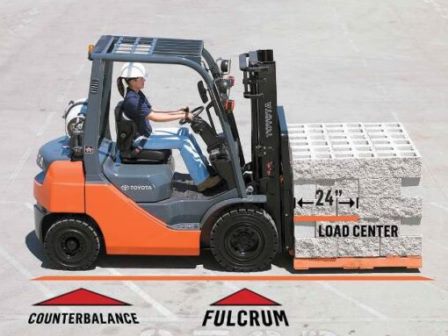Essential rules when operating, driving, and maneuvering forklifts
- Observe all traffic regulations, including authorized plant speed limits. Maintain a safe distance, approximately three truck lengths from the truck ahead, and keep the truck under control at all times.
- Always look in all directions before continuing.
- Always look in the direction of travel. If cargo blocks your view, travel in reverse. Keep a clear view.
Powered industrial truck safety tips
This safety tip looks at the rules and regulations concerning forklift safety and provides tips for eliminating powered industrial trucks hazards.
- Yield to ambulances, fire trucks, or other vehicles in emergency situations.
- Do not pass other trucks traveling in the same direction at intersections, blind spots, or other dangerous places.
- Cross train tracks diagonally whenever possible. Do not park within 8 feet of the center of the railroad tracks.
- Operate at a speed that allows the truck to stop safely in all travel conditions.
- Don’t participate in stunts or rough play.
- Slow down for wet and slippery floors.
- Drive on them carefully and slowly and never exceed their indicated capacity.
- Approach the elevators slowly and enter directly after the elevator car is properly leveled. Once in the elevator, neutralize the controls, turn off the power, and set the brakes.
- Separate forklift and pedestrian traffic as much as possible. Use established walkways with guardrails and strictly enforce their use.
- Never carry passengers.
- Keep arms or legs within the confines of your vehicle.
- Be aware of surface obstructions; even a small bump can cause a load to fall off the raised forks.
- Never go near anyone who is in front of a bench or any other fixed object.
- Do not travel to a position where if the forklift jumped forward, the brakes failed, or the wrong lever was pressed, a co-worker could be caught between the forklift and another object.

Powered industrial trucks must be inspected
Powered industrial trucks are used in many industries to move materials.
The hazards commonly associated with powered industrial trucks vary depending on the type of vehicle and the workplace where the truck is used.
Each type of truck presents different operational hazards.
For example, a counterbalanced sit-down truck is more likely to be involved in a cargo accident than a motorized hand truck, because the sit-on truck can lift a much higher load than a hand truck.
Workplace conditions also present different hazards. For example, retail establishments often face greater challenges than other workplaces in maintaining pedestrian safety.
The best way to protect employees from injury also depends on the type of truck operated and the workplace where it is used.
According to OSHA a powered industrial truck is unattended
A powered industrial truck is unattended when the operator is 25 ft. or more away from the vehicle which remains in his view, or whenever the operator leaves the vehicle and it is not in his view.
Labor laws on hazardous occupations prohibit employees under the age of 18 from operating forklifts, employers must ensure that workers under the age of 18 are not authorized to operate forklifts under any circumstances.

Powered Industrial Truck
- What qualifies as a powered industrial truck?
- What is a powered industrial truck?

As the load center on the forklift increases the weight capacity, does what?
How does increasing the load Centre affect the capacity of a forklift truck?

Forklift Safety Procedures
Forklifts are extremely useful workplace vehicles, as long as they are used safely and appropriately by operators who are appropriately trained and competent to use them.
